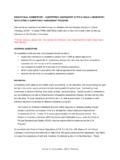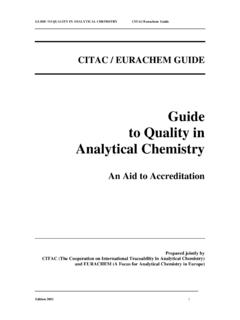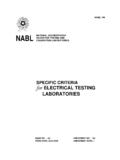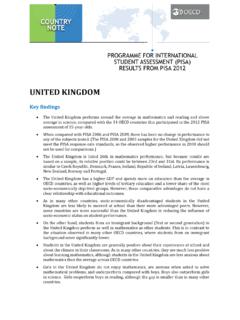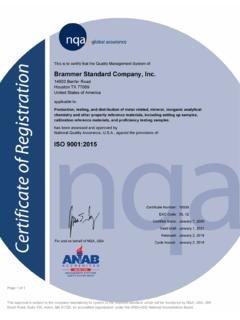Transcription of Standards for Cannabis Testing Laboratories
1 Standards for Cannabis Testing Laboratories Cannabis Safety Institute December, 2014 Authors and Contributors Pete Unger1,2 Roger Brauninger1 Chris Hudalla, PhD3 Mowgli Holmes, PhD4 Bethany Sherman5 1A2LA, Frederick, MD 2 ILAC, Rhodes, Australia 3 Proverde Laboratories , Milford, MA 4 Phylos Bioscience, Portland, OR All rights reserved. 5OG Analytical, Eugene, OR Cannabis Safety Institute, 2014 2 Table of Contents Introduction 3 Laboratory Accreditation 4 Scope of Accreditation 7 proficiency Testing 8 Methodologies 9 Management 12 Conclusion 13 Summary of Recommendations 14 3 Introduction Prior to the legalization of recreational Cannabis in Washington and Colorado.
2 A number of Cannabis Testing Laboratories were already in operation in those and several other states. These Laboratories primarily served the market for potency Testing of medical marijuana, although they had begun to offer such services as microbiology Testing . They were entirely unregulated, and in some states even their legality was unclear. As Washington and Colorado began structuring their legal recreational Cannabis programs, these states included rules requiring safety Testing of Cannabis . Oregon added similar rules to its medical marijuana program.
3 In the absence of traditional analytical chemistry Laboratories able or willing to test Cannabis , these states have turned to the existing Cannabis Testing industry to meet their mandated Testing requirements. In response to this increase in demand, roughly 30 new Cannabis Testing Laboratories have opened in 2014. Washington and Colorado have introduced programs to inspect and certify these Laboratories , but there has been a good deal of confusion over what tests the Laboratories should perform and what Standards they should be held to.
4 No other state has put an oversight program into place. Oregon recently began to require that all medical Cannabis be tested, yet has failed to address the legality of the Laboratories performing this work. Faced with regulating an entirely new large-scale agricultural product in the absence of any guidance from the United States Department of Agriculture (USDA) and the Food and Drug Administration (FDA), many state regulatory agencies have determined that some safety Testing is better than no safety- Testing whatsoever. This assessment is misguided.
5 In fact, inadequate Testing is less safe than no Testing . A laboratory that performs analytical chemistry and microbiology Testing is an extraordinarily difficult business to design, equip and operate properly. There are clear and internationally accepted Standards for proper laboratory operation, but none of the Cannabis Testing Laboratories that have opened in the last year currently meet these Standards . Many are run by inexperienced analytical chemists, or by non-scientists. Many of them purport to offer tests that are known to be expensive and time-consuming, for far less than the cost of the materials required to perform them.
6 These Testing Laboratories frequently return only pass/fail information, rather than quantitative results. Most concerning, many reports indicate that when the majority of these Laboratories are given identical samples, they return results with very little correlation. 4 Laboratory Accreditation It is in the interest of public health and safety to have qualified and regulated Laboratories certifying the safety of products. It is better to have no Testing than to have products sold with misleading certificates of safety. Adequate safety Testing for Cannabis is an attainable goal.
7 Many of the existing Cannabis Testing Laboratories are now well-staffed and well-funded. Competent Laboratories will have little difficulty meeting the accreditation criteria used by both the private sector and the governmental regulatory bodies that oversee the Laboratories that test our food, soil, medicines, and drinking water. These criteria are consolidated in the International Organization for Standardization (ISO) guidelines known as ISO 17025 (General requirements for the competence of Testing and calibration Laboratories ), and they are clear, effective, and universally accepted.
8 Most safety- Testing Laboratories in this country, including many government Laboratories at both the state and federal level, are accredited to this standard, by a third-party accreditation body that itself has been shown to operate in conformance to the internationally accepted ISO 17011 standard for accreditation bodies. The Testing of Cannabis must be performed by Laboratories that have been able to demonstrate their competence through well-established accreditation mechanisms. Accreditation is a formal recognition by an authoritative third-party of a laboratory s competence to perform specific tests.
9 This accreditation infrastructure is well established by the mutual recognition arrangement (MRA) among accreditation bodies through the International Laboratory Accreditation Cooperation (ILAC). ILAC functions as a forum for harmonizing laboratory and inspection body accreditation procedures and policies, thus promoting accreditation as a mechanism to enhance confidence in Testing and inspection facilities. ILAC member accreditation bodies are recognized as competent to accredit Testing and inspection organizations through a rigorous peer evaluation process: accreditation bodies must meet the requirements of ISO 17011 and use ISO 17025 as the basis for accreditation of Testing Laboratories .
10 ILAC was formed more than 30 years ago and the ILAC Arrangement (MRA) has been in place for nearly 15 years. Many State and Federal agencies utilize the third party accreditation of Laboratories as criteria for their recognition, because this status provides assurance that the laboratory is meeting the necessary 5 quality requirements. For example, the Consumer Product Safety Commission relies on accreditation of third-party Laboratories that are Testing in conformance with the Consumer Product Safety Improvement Act of 2008 and requires that children s toys must be tested by a laboratory accredited to ISO 17025 by an accreditation body that is a signatory to the ILAC MRA.

